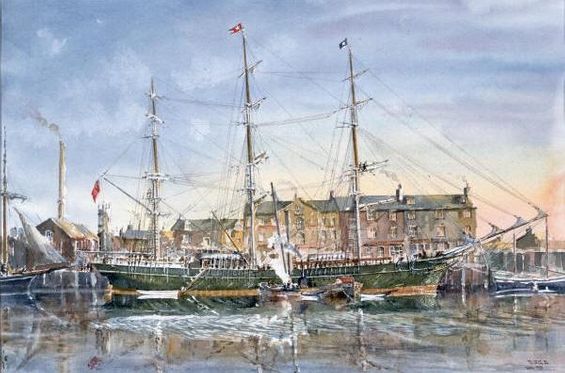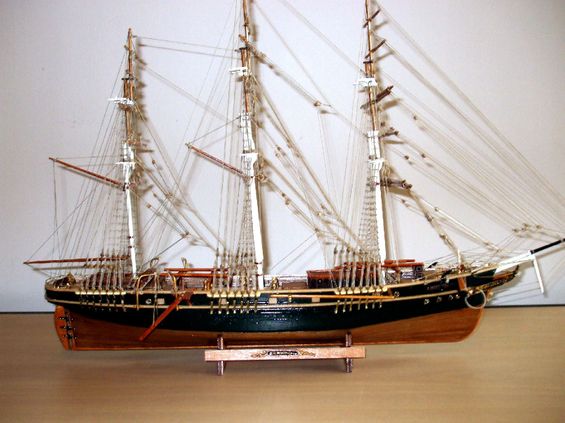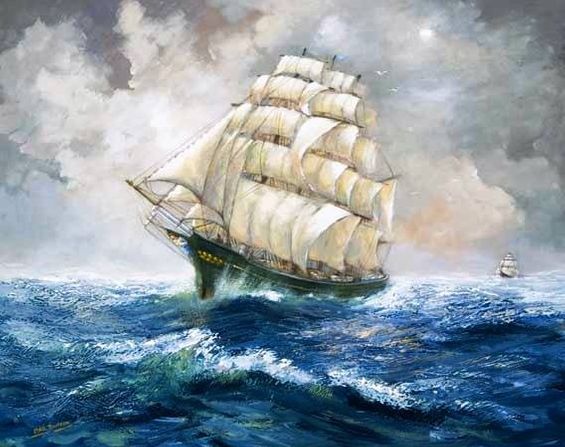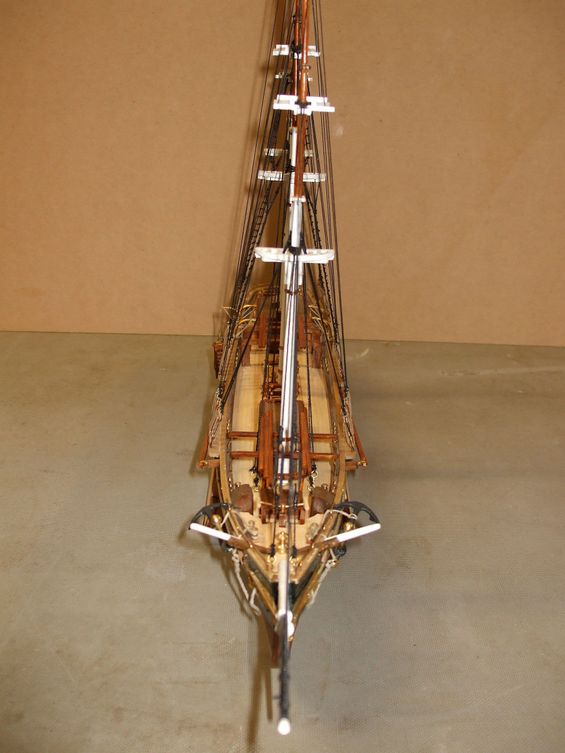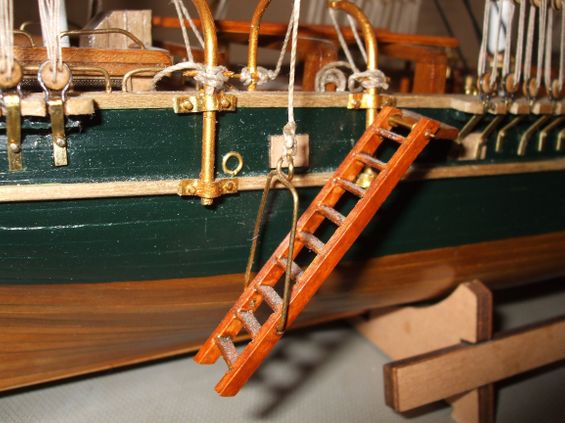Classic Ship Models 23
A PROFILE
Thermopylae at Aberdeen on maiden yoyage
Thermopylae 1868 - 1907
A Profile of the famous British Clipper Ship
The Thermopylae was launched on August 19th 1868 for the Aberdeen White Star Line from the
shipyard of Walter Hood and Company. She was christened by Mrs Hardy Robinson of Denmore and commanded by Captain Edward, previously of the "Ethiopian". She was built to the highest standards of her time and intended for the London to China tea trade.
All of George Thomson's Aberdeen White Star Line were noted for their handsome appearance, dark green hull, gilded scroll work and white masts. The figurehead represented the Greek hero Leonadis, King of Sparta.
In London, a Captain Robert Kemball took over for the voyage to Melbourne, sailing on the 8th November 1868 and arriving on the 9th January 1869 in the record time of 63 days. The Melbourne Age reported that ".... it seemed impossible that a voyage to the Antipodes could be accomplished in 59 days, the period it took to get within sight of the Australian coast. She is, in every respect, a fine specimen of naval architecture, a model of symetry and beauty with her sweeping lines and exquisite proportions"
A composite clipper ship, she was 991 tons GRT, 948 gross tons NRT, 927 tons underdeck.
Her dimensions were :- Overall length 212 ft Breadth 36 ft Depth 20' 9"
THE MODEL
The Model of Thermopylae
"THERMOPYLAE" 1868 - 1907
Famous British Clipper Ship
This
model of Thermopylae is made from a kit supplied by Mantua Sergal of Italy. It is on a scale of 1:124 and, as such , is quite a challenge to the model maker in handling the delicately small components. Her length is 575 mms with a height of 375
mms and hull breadth of 85 mms. Her overall breadth at the widest yard is 185 mms. She is constructed in the usual double plank on frame system mainly using ramin, limewood and walnut. To ensure reasonable authenticism, she is painted in colours as close
as possible to the original vessel - with dark green hull to the waterline and varnished timbers below and on the superstructures. The masts are in traditional White Star Line white with varnished yards. (Unfortunately, the dark green shows up as nearly
black in the photographs)
On a scale of 1 - 6, with 6 being the most difficult for highly experience modellers, the Thermopylae is rated 3. Due a sparsity of detailed explanatory notes, it relies on the modeller to correctly interpret the guidelines and rigging diagrams. The brass fittings are of good quality as are the timbers. The rigging cottons are very fine and the blocks, all single, are a little hard to handle. With patience, the final outcome will provide a great deal of satisfaction. This one was commenced in November 2008 and finished in February 2009, taking 112 days consisting of approximately 300 hours of leisure time.
In due course, this model was passed on to my son on his 50th birthday in 2010 and now stands in his office. Having given me so much pleasure, I purchased and built a second identical model which turned out to be just as attractive as the first.
Thermopylae - A History of Achievements
Thermopylae in full sail
"THERMOPYLAE"
A History of her Achievements
Continuing on her maiden voyage, described
above, Thermopylae left Melbourne on January 22 1869 and arrived in Newcastle NSW on the 30th, thence sailing to Shanghai on 10th February, arriving on 13 March - a record passage of 31 days.
1869 3rd July - 30th September Foochow to London in 91 days
1870 30th July - 12th November Shanghai to London in 105 days
1871 25th June - 6th October - Shanghai to London in 103 days
1872 18th June - 11th October Thermopylae left Shanghai with a cargo of tea for London in company with the London clipper Cutty Sark. After racing each other for two weeks, the Cutty Sark lost her rudder after passing through the Sunda Straits. Thermopylae arrived in London only 7 days ahead of her rival.
1873 11th July - 27th October Foochow to London in 100 days
1874 - 1881 Despite her fame in the tea trade, Thermopylae made more voyages to Australia in the wool trade
1889 Sold to W Ross and Co of London
1890 Sold to Redfords of Montreal, a Canadian company, for 5,000 pounds and placed on the rice and timber trade between Rangoon and Vancouver. Although she was cut down to a barque rig in July 1893, with shortened masts and the crew reduced from 32 men to 20 men, she continued to make speedy passages. On one occasion she crossed the Pacific in 29 days and on another occasion, she kept pace for three days with the Canadian Pacific steamship "Empress of India" which was capable of 16 knots.
In 1897 she was sold to the Portuguese Navy as a training ship and renamed "Pedro Nunes" after a Portuguese 16th century mathematician and geographer. Later she was converted to a coal hulk and eventually sunk by gunfire and torpedoes by units of the Portuguese Navy as target practice on the 13th October 1907
In June 2003, a group of Portuguese divers found the remains about 30 metres down, off the coast of Lisbon. The hull is buried in sand but enough was visible to identify her as the Thermopylae. A very sad end for a truly magnificient vessel.
Thermopylae under construction showing slender lines, spare timbers on deck housing and generally clear decks, January 2009.
The sleek and slender lines are emphasised in this view from forrard.
This shows the more 'modern' gangway of the mid 19th century on the Thermopylae as well as the newer type of chain plates.

